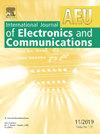飞机准圆锥选频表面天线罩的高效建模方法
IF 3.2
3区 计算机科学
Q2 ENGINEERING, ELECTRICAL & ELECTRONIC
Aeu-International Journal of Electronics and Communications
Pub Date : 2025-07-20
DOI:10.1016/j.aeue.2025.155948
引用次数: 0
摘要
频率选择表面(FSS)可以有效地减小空腔的雷达截面(RCS),使其非常适合布置在战斗机前部的准锥形天线罩上。这种类型的天线罩通常是不可开发的表面,而目前的学术研究缺乏专门针对飞机机头配置的准锥形FSS天线罩的专用建模方法。针对这一问题,本文提出了一种在新一代战斗机机头拟锥形天线罩上构建复杂FSS阵列的有效建模方法。该方法利用虚拟可展开圆锥模具实现准圆锥不可展开曲面的最小畸变展平,建立了最小畸变平坦展开平面与原不可展开天线罩曲面之间的完整映射关系。这种映射可以将预先设计的FSS阵列从最小失真平面线性转移到不可展开的天线罩表面,从而生成机头配置的准锥形FSS天线罩的3D数字模型。与传统方法相比,该方法在不影响建模精度的情况下建立了最小失真的完整映射,而只需要传统技术约30%的计算时间。这大大提高了拟锥形不可展开天线罩表面上复杂FSS阵列建模的计算效率。本文详细介绍了该方法的建模过程,并通过在两种典型战斗机的天线罩上构建FSS阵列验证了该方法的有效性。本文章由计算机程序翻译,如有差异,请以英文原文为准。
Efficient modeling method for Quasi-Conical frequency selective surface radomes of aircraft
Frequency selective surfaces (FSS) can effectively reduce the radar cross section (RCS) of cavities, which makes them ideally suited for arrangement on quasi-conical radomes positioned at the forward section of fighter aircraft. Radomes of this type are typically non-developable surfaces, while current academic research lacks dedicated modeling methodologies specifically for aircraft nose-conFigured quasi-conical FSS radomes. This paper focuses on addressing this challenge by proposing an efficient modeling method for constructing complex FSS arrays on new-generation fighter aircraft nose-conFigured quasi-conical radomes. The method employs a virtual developable conical mold to achieve minimal-distortion flattening of quasi-conical non-developable surfaces, establishing a complete mapping relationship between the minimally distorted flat-unfold plane and the original non-developable radome surface. This mapping enables linear transfer of pre-designed FSS arrays from the minimal-distortion flat-unfold plane to the non-developable radome surface, thereby generating a 3D digital model of the nose-conFigured quasi-conical FSS radome. Compared to traditional methods, this approach establishes a minimum-distortion complete mapping without compromising modeling accuracy while requiring only approximately 30% of the computational time of conventional techniques. This significantly enhances computational efficiency for modeling complex FSS arrays on quasi-conical undevelopable radome surfaces. The process of the modeling is presented in this paper in detail, and the effectiveness of the proposed method is validated by constructing FSS arrays on radomes of two typical types of fighter aircraft.
求助全文
通过发布文献求助,成功后即可免费获取论文全文。
去求助
来源期刊
CiteScore
6.90
自引率
18.80%
发文量
292
审稿时长
4.9 months
期刊介绍:
AEÜ is an international scientific journal which publishes both original works and invited tutorials. The journal''s scope covers all aspects of theory and design of circuits, systems and devices for electronics, signal processing, and communication, including:
signal and system theory, digital signal processing
network theory and circuit design
information theory, communication theory and techniques, modulation, source and channel coding
switching theory and techniques, communication protocols
optical communications
microwave theory and techniques, radar, sonar
antennas, wave propagation
AEÜ publishes full papers and letters with very short turn around time but a high standard review process. Review cycles are typically finished within twelve weeks by application of modern electronic communication facilities.

 求助内容:
求助内容: 应助结果提醒方式:
应助结果提醒方式:


